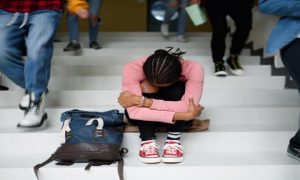In one sense, this is how it was always supposed to go: When viruses evolve, vaccines should follow, and sometimes try to leap ahead. The COVID-19 shots that the U.S. has used to inoculate hundreds of millions of people are simply so new that they’ve never had to undergo a metamorphosis; up until now, their original-recipe ingredients have stood up to SARS-CoV-2 well enough. But the virus they fight has changed quite radically, and this fall, the vaccines will finally, finally follow suit.
Today, an advisory committee to the FDA recommended that our current slate of shots be updated to include a piece of an Omicron subvariant, with the aim of better tailoring the vaccine to the coronavirus variants that could trouble us this fall. Neither the agency nor its outside expert panel has yet reached consensus on which version of Omicron will be the best choice, and whether the next round of shots will still contain the original version of the virus as well. Regardless, a new formulation with any bit of Omicron will constitute a bet that these ingredients will better protect people than another dose of the original vaccine recipe, whose protective powers have been fading for many months.
The virus’s own mutational hijinks will determine, in part, how well that wager pays off. But for it to work at all, people have to actually get the shots. “A vaccine without vaccination is an exercise in futility,” says Stephen Thomas, the director of the University of Maryland’s Center for Health Equity. The protective power of COVID shots will depend heavily on their reach: The more people who get them as recommended, the better they’ll work.
Here in the U.S., vaccine enthusiasm has a pretty dire prognosis. Fewer than half of the vaccinated Americans eligible for a first booster have opted for one; an even paltrier fraction of those who could get second and third boosters are currently up-to-date on their shots. Among high-income countries, the U.S. ranks embarrassingly low on the immunity scale—for a nation with the funds and means to holster shots in spades, far too many of its residents remain vulnerable to the variants sweeping the globe, and the others that will inevitably come.
Those numbers are unlikely to budge in future inoculation rounds, unless “we do something very dramatically different,” says Kevin Schulman, a physician and economist at Stanford University. The next round of vaccines could start its roll out by early October, depending on its contents, making this autumn the first COVID-shot update of the rest of our lives—and marking one of the ways we’ll have to permanently incorporate SARS-CoV-2 into our thinking. The round of shots rolled out this fall, then, won’t just be a sequel to the injections of the past year and a half; it will be a chance for a true cultural reboot. By year’s end, America will likely set a vaccine precedent, either breaking its pattern of injection attrition or further solidifying it, and letting the virus once again lap us.
From the beginning, the messaging on COVID boosters has been a bungled mess. Originally, it seemed possible that a duo of doses, perhaps even a single shot, would be enough to block all infections, and bring pandemic precautions to a screeching halt. That, of course, was not the case. With the virus still spreading last summer and fall, experts began heatedly debating what purpose extra doses might serve, and who should get them—and if they were needed at all. Caught in the cross fire, the FDA and CDC issued a series of seemingly contradictory communications about who should be signing up for extra shots and when.
Then BA.1—the original Omicron subvariant—arrived. This variant was so mutated that it was tough to stave off with one or two original-recipe doses alone, and suddenly far more experts agreed that everyone would benefit from an immunity juice-up. By the end of 2021, the U.S. had a catchall booster recommendation for adults (and has since expanded it to kids as young as 5), but whatever the benefit of a booster might be, much of the public had disengaged. Many had been infected by then, and even people who had gladly gotten doses one and two couldn’t muster the same urgency or enthusiasm again. “The feeling was, I’ve already gotten one series of shots—I’m not just going to keep getting more,” especially with no obvious end to the injection rigamarole in sight, says Stacy Wood, a marketing expert at North Carolina State University who, with Schulman, has written about the challenges of promoting COVID-19 vaccines.
The shots have also become much harder to get. Mass vaccination sites have closed, especially affecting low-income and rural regions, where there’s a dearth of medical centers and pharmacies. Pandemic funds have dried up, imperiling shot supply. Ever-changing recommendations have also created an impossible-to-navigate matrix of eligibility. Since the booster rollout began, recommendations on when to boost and how many times have shifted so often that many people haven’t realized the shots were actually available to them, or were mistakenly turned away from vaccination sites that couldn’t parse the complex criteria dictating who was allowed an extra dose. Pile onto that the persistent problems that have stymied initial vaccinations—a lack of paid sick leave, fears of side effects, the hassles and costs of scheduling and traveling to a shot—and it sends a message: The shots can’t be so necessary if they’re this cumbersome to get.
The country’s loosened stance on the pandemic as of late has reinforced the shots’ optional status. With COVID death rates near their all-time low—thanks largely to vaccines—infections, which have now hit a majority of Americans, continue to be dismissed as manageably “mild.” Mask mandates, testing programs, and gathering restrictions have evaporated. And so have what vaccination requirements existed.
“People just aren’t as concerned,” says Mysheika Roberts, the health commissioner of Columbus, Ohio. “The fear of the virus has changed a lot.” Of the 230,000 vaccines Roberts’s team has delivered to her community since December 2020, only 16,000 have been boosters. In an atmosphere of mass relaxation, the urgency of more vaccines—a reminder of the pandemic’s persistent toll—simply doesn’t register. Compared with the pandemic’s early days, we’re now “fighting complacency and fatigue” that wasn’t bogging us down before, says Angela Shen, a vaccine expert at Children’s Hospital of Philadelphia. Immunization ennui has created cracks into which anti-vaccine misinformation has quickly seeped. “It allowed the dominance of the negative messages,” Schulman told me, with a fervor that pro-vaccine messages have yet to match.
With any vaccine, “there’s going to be a certain percentage drop-off each time you ask people to come back in,” says Elaine Hernandez, a sociologist and health demographer at Indiana University Bloomington. But America’s approach to boosters took that natural chasm and stretched it further out. This year, well-timed boosters, delivered in advance of winter, could blunt the wave that many experts forecast will begin to crash over the nation by year’s end. Recent modeling suggests that SARS-CoV-2 could kill up to 211,000 people from March 2022 to March 2023—making new vaccines essential to stem the tide. As things stand, the U.S. has little planned from now until the fall to make this booster push more successful than the last, and communicating the shots’ benefits will be far more difficult than it was in 2021, when the vaccines were fresh. If anything, the next rollout threatens to be one of the most constrained distribution efforts yet: COVID funding remains in congressional limbo, and federal officials have fretted that “we’re not going to have enough vaccines for every adult who wants one” this fall. If the current trends continue, “I don’t think we’re going to do any better” than the boosting rates the country has already clocked, Shen told me.
That doesn’t have to be the case. With our first several vaccine rollouts, “we messed up,” Thomas, of the University of Maryland’s Center for Health Equity, told me, because the nation’s priorities were misaligned. Although billions of dollars were funneled to pharmaceutical companies so they could develop COVID vaccines in record time, no proportionate allocation of resources went to ensuring that those shots actually found their way into arms. And so, too many of them did not.
The fall boosters will reignite those communication challenges, and add some of their own. The new formulation, selected months ahead of schedule, remains an inherent gamble. “We need an updated shot,” Shen told me. That decision has to happen now, in order for boosters to be manufactured by fall. But there’s no telling what Greek-letter threat will be ping-ponging around the globe by the time winter sets in, or how good a match the shots will be. Whatever Omicron variant is slotted in may no longer be pertinent by the time October begins. If BA.1 is the agency’s choice, that’s already the case. A BA.4- or BA.5-inspired shot might feel more current—but such a selection could push the entire timeline back: Some vaccine makers have already said they might need more time to cook up those shots en masse.
Still, introducing (or reintroducing) vaccinated people’s bodies to any Omicron spike should broaden their defenses, even if the variant isn’t a perfect match for the version of the virus they see next. Should the FDA select a two-spike shot that includes the original variant as well, it will also offer immune systems a reminder of the SARS-CoV-2 morphs they’ve encountered before. The new message has to be that “the virus has changed, and now the vaccines have changed,” says Elizabeth Wrigley-Field, a sociologist at the University of Minnesota.
The shots’ selling points, though, won’t be the same across the country. From the beginning, people have gotten vaccines for different reasons, on different schedules; attempting to collapse that diversity now may fail to actually bring people together. “The local variation is just remarkable,” Hernandez told me. Policies specific to one location just can’t be expected “to work the same way somewhere else.”
For enthusiasts—people who can’t wait to dose up again—health officials might do well to play up the novelty of the autumn vaccine recipe, the hottest new model to hit the shelves. “The upgrade mentality is compelling,” Wood, of North Carolina State University, told me. “People like to have the most cutting-edge thing.” That won’t fly with everyone, however. Newness was the very thing some people feared about the COVID vaccines to begin with, Wood pointed out; highlighting an unfamiliar version of an already foreign-seeming product could exacerbate those concerns. To revamp communications around the new recipe, experts might even consider moving away from the term booster, a word people have come to link with the peak of pandemic crisis, and simply refer to regularly reformulated COVID vaccines as “another annual shot,” Schulman told me. A term like that might help soften “the emotional tone,” he said. People are already used to getting shots in the fall, thanks to the flu—a COVID vaccine could piggyback on that routine.
And in many of the communities that Thomas has worked with, people aren’t hinging their vaccination decisions heavily on the shots’ exact formulation, he said. Far more important is “who’s delivering it.” Any successful vaccination effort, he said, survives on maintaining trust long-term. “Once you have trust, everything flows from there.”
His own efforts to increase vaccination have built on that principle—which has meant shifting the venues in which people expect to receive their shots. For more than a year, he and his colleagues have been been partnering with Black barbers and stylists across the country to turn hair salons into COVID immunization sites, where regulars can stop in for a trim, a shave, and a jab, all while getting their questions answered in a space that feels familiar and safe. The experts talking up the shots are often shop owners—“people they know from the community,” Thomas told me. “It’s about wrapping the message in a way that’s nonthreatening.” The same goes, he told me, for just about any vaccination drive. Many people are just eager to keep their loved ones safe, he told me, and want to hear that that’s possible to achieve from a nonjudgmental source. Messages like “Don’t let COVID come to your family reunion” and “Are your kids max-boosted?” partnered with images of grandmothers and children strongly resonate.
Whatever the scale, the more infrastructure that’s around to support continued immunizations, the better. Reopening vaccination venues, with the help of renewed federal funds, this fall would help; so would reigniting outreach that brings shots to low-resource communities. Wrigley-Field notes that another crucial priority is maintaining access to vaccines, including first doses—the foundation on which boosters build. “There is this assumption that people have had their chance, and that mass vaccination sites and outreach campaigns are no longer needed,” she told me. “And I think that is just so wrong.” In Minnesota, she’s been working to deliver vaccines with the help of leaders from local mosques and pharmacies; a year and a half in, “we still find people who want to get their first shots when we talk with them,” she told me. “And there are people who know they want boosters, but haven’t had the opportunity, and people who are on the fence, but can decide to get it pretty quickly in a conversation where they can ask their questions.”
For all the discussions that people have been having about what to put into our next vaccines, Thomas told me, “I’ve not heard anything about how that’s going to be communicated and rolled out.” Those conversations, he said, need to launch now, or risk never getting off the ground at all.





























